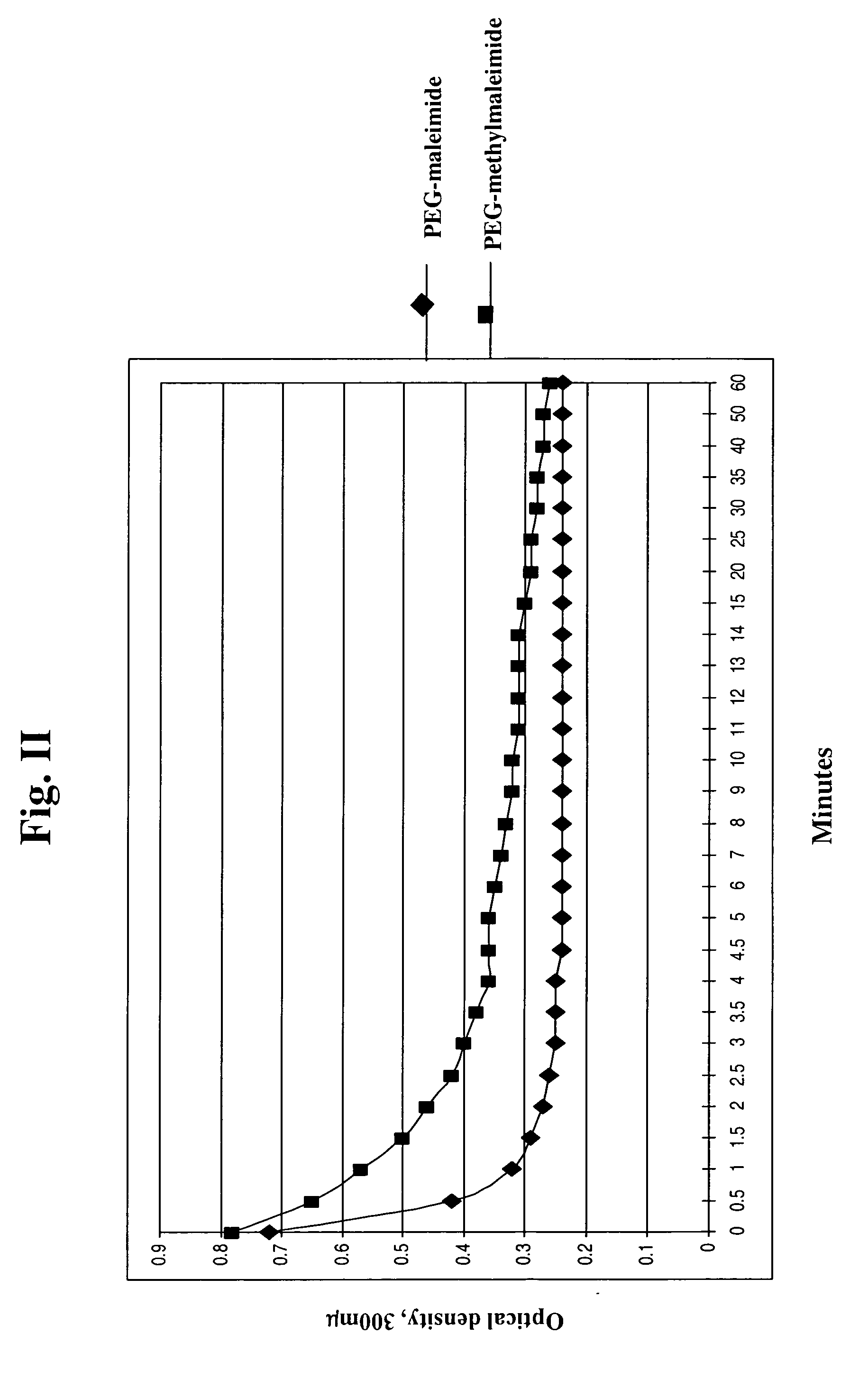Methylmaleimidyl polymer derivatives
a technology of methylmaleimidyl and polymer, which is applied in the field of pegylating therapeutic proteins, can solve the problems of short in vivo half-life, difficult purification, and unsuitable pharmaceutical use, and achieve the effects of enhancing the degree of in vivo stability, and reducing the risk of toxicity
- Summary
- Abstract
- Description
- Claims
- Application Information
AI Technical Summary
Benefits of technology
Problems solved by technology
Method used
Image
Examples
example 1
[0059] Preparation of
[0060] Citraconic anhydride 2 (290 mg, 2.5 mmol) was added to a solution of (o-methoxypoly-(oxyethylene)amine 1 (MW 20,000, 5 g, 0.25 mmol) in N,N-dimethylacetamide (20 ml) at 40EC for 2 h. The reaction was cooled, diluted with ether (250 ml) and refrigerated overnight. The citraconic acid mono amides 3 and 4 were filtered, washed with ether and dried under vacuum. The mixture of amides were then dissolved in a 4:1 mixture of methylene chloride and DMF (25 ml) to which was added diisopropylethylamine (2.5 mmol, 0.43 ml) and pentafluorophenyl trifluoroacetate 5 (2.5 mmol, 0.43 ml) and the solution stirred for 24 hrs at 50EC. The mixture was then slowly added with stirring to ether (200 ml) and the resulting mixture refrigerated for 12 hrs. The precipitate was filtered, washed with ether and dried under vacuum. The maleimide 6 was then dissolved in a minimum of methylene chloride and allowed to stand over activated charcoal. The mixture was filtered through celi...
example 2
[0061] Preparation of
[0062] To a stirred solution of citraconic anhydride 2 (1.14 g, 10.2 mmol) in 5 ml of dry DMF was added 3-aminopropionic acid 7 (0.91 g, 10.2 mmol). After stirring for 8 hours under nitrogen, the reaction mixture which contained the citraconic acid mono amides 8 and 9 was cooled to OEC and diisopropylethylamine (4.4 ml, 25.5 mmol) dissolved in 6 ml of dry DMF was added followed by a solution of pentafluorophenyl trifluoroacetate 5 (7.2 g, 4.4 ml, 25.5 mmol) in 6 ml of the same solvent. The reaction was stirred at room temperature under nitrogen for 18 hours. Water (50 ml) was then added to the reaction mixture and extracted with methylene chloride. The methylene chloride solution was dried over magnesium sulfate and the solvent removed under reduced pressure to give the the petafluorphenyl-3-maleimido-propane-1-carboxylate 10. To 251 mg (0.75 mmol) of 10 dissolved in 30 ml of methylene chloride was added mPEG amine 11 (MW 20,000, 5 g, 0.25 mmol) and the soluti...
example 3
[0063] Preparation of
[0064] By following the same procedure as described in Example 2, the PEG dianine 13 is reacted with two moles of the 3-methylmaleimido ester 10, gives the product 14.
The integer n may be from about 20 to 2,300 but more preferably 20 to 1,000.
PUM
| Property | Measurement | Unit |
|---|---|---|
| molecular weight | aaaaa | aaaaa |
| molecular weight | aaaaa | aaaaa |
| molecular weight | aaaaa | aaaaa |
Abstract
Description
Claims
Application Information
 Login to View More
Login to View More - R&D
- Intellectual Property
- Life Sciences
- Materials
- Tech Scout
- Unparalleled Data Quality
- Higher Quality Content
- 60% Fewer Hallucinations
Browse by: Latest US Patents, China's latest patents, Technical Efficacy Thesaurus, Application Domain, Technology Topic, Popular Technical Reports.
© 2025 PatSnap. All rights reserved.Legal|Privacy policy|Modern Slavery Act Transparency Statement|Sitemap|About US| Contact US: help@patsnap.com



